A city that truly never sleeps, Tokyo is the largest city in the world when measured by urban area and total population. The metropolitan area of Tokyo is home to nearly 40 million people and the city has been the capital of Japan since 1868. As one of the world’s most famous cities, it also features an iconic skyline, as you’ll discover with our list of famous Tokyo landmarks. Tokyo has held the top spot as one of the world’s most populous cities for nearly 300 years. Even as far back as the mid-1700s, the city had over one million people.
Today bustling Tokyo is a city of many contrasts. Huge modern skyscrapers tower over ancient temples, and perfectly manicured parks and Japanese gardens offer respite from the urban sprawl. It’s at night that Tokyo comes alive. After dark, Tokyo’s streets and alleyways are illuminated by the dazzling lights of countless bars, cafes and pachinko parlours. There’s enough to explore in Tokyo to fill a lifetime. But if you’re visiting the city, here are 20 landmarks in Tokyo that are not be missed.
Contents
- Tokyo Landmarks
- 20 Landmarks In Tokyo You Must See
- 1- Tokyo Tower
- 2- Sensoji Temple
- 2- The Rainbow Bridge
- 3- Hachiko Memorial Statue
- 4- Tokyo Station
- 5- Shinjuku Gyoen National Garden
- 6- Shinjuku’s Godzilla Head
- 7- Gotokuji Temple
- 8- Tokyo Skytree
- 9- The Shibuya Scramble Crossing
- 10- Akasaka Palace
- 11- Ueno Park
- 12- Tokyo Dome
- 13- Meiji Jingu Shrine
- 14- Takeshita Dori
- 15- Fuji TV Network Headquarters Building
- 16- Unicorn Gundam Statue
- 17- Tokyo Metropolitan Government Building
- 18- Roppongi Hills
- 20- Mount Fuji
- 20 Landmarks In Tokyo You Must See
Tokyo Landmarks
20 Landmarks In Tokyo You Must See
1- Tokyo Tower
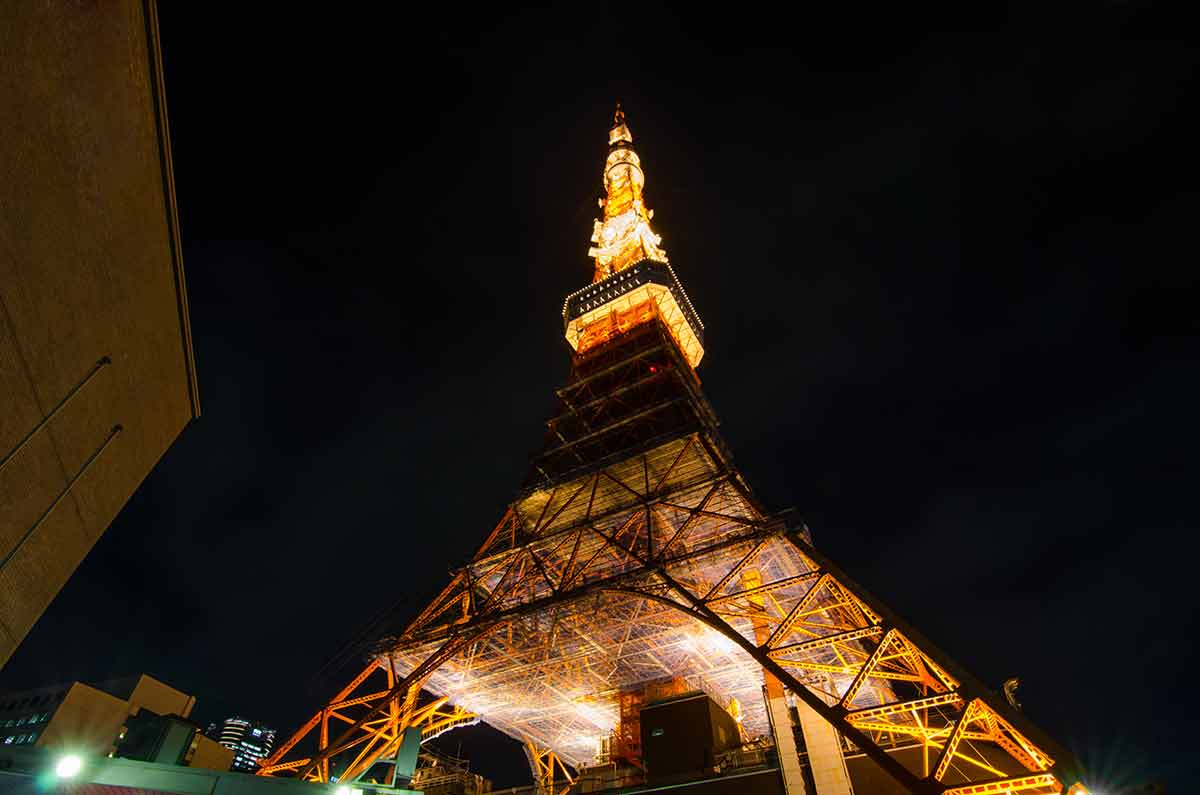
Despite all the competition, Tokyo Tower remains the most famous of all of Tokyo’s landmarks.
Constructed in 1958, the Tokyo Tower is primarily a broadcasting tower for radio and television antennas.
Modelled on Paris’ Eiffel Tower, it is more famous as an observatory.
Over 150 million people have walked through the doors of Tokyo Tower since it first opened.
Featuring two observation decks, when it opened, the Tokyo Tower became the tallest tower in the world, ironically surpassing its inspiration, the Eiffel Tower.
It remains the second tallest structure in Japan to this day.
Painted bright orange to comply with air safety laws, the Tokyo Tower is beautifully illuminated at night.
On summer nights, the tower is lit up with a cooling white light and a warming orange in the winter.
Tokyo Tower is at 4-2-8 Shibakoen, Minato City, Tokyo 105-0011.
2- Sensoji Temple
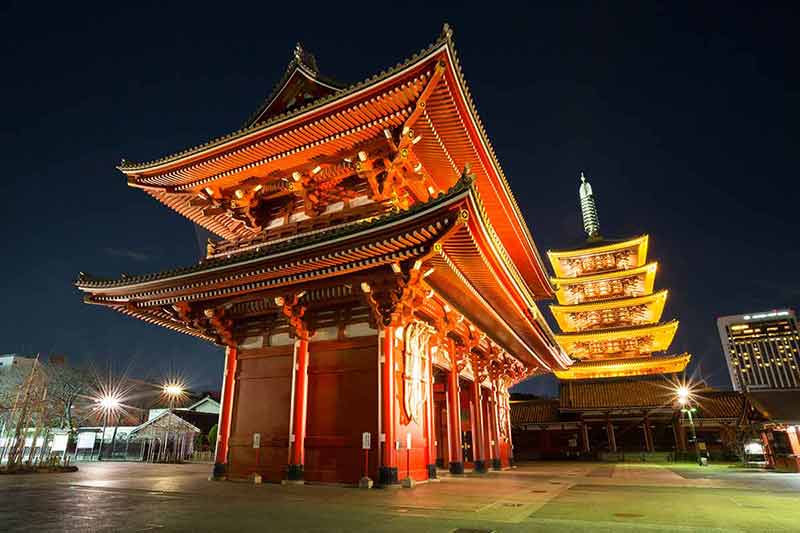
Sensoji Temple is Tokyo’s oldest temple, originally dating from 645AD.
Rebuilt mainly following the Second World War, Sensoji is the most famous temple in the city.
Much loved by tourists and Tokyoites alike, Sensoji Temple is possibly the most visited spiritual place in the world, with over 30 million visitors each year.
Giant red lanterns hang from Sensoji Temple’s two imposing entrance gates, Kaminarimon and Hozomon.
Between the two gates on the approach to the main temple buildings is Nakamise-dori, a long street filled with traditional shops selling various snacks and souvenirs.
At the heart of Sensoji Temple is the main hall, where you can offer prayers to Kannon Bosatsu, the Buddhist God of compassion, and Sensoji’s magnificent five-storey pagoda.
Sensoji Temple is at 2-3-1 Asakusa, Taito City, Tokyo 111-0032.
2- The Rainbow Bridge
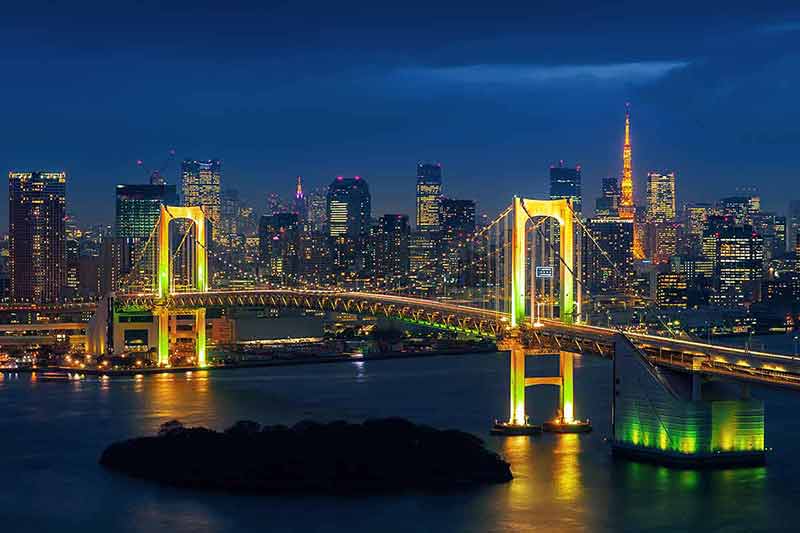
At almost 800 m long, the Rainbow Bridge towers over Tokyo Bay.
The suspension bridge connects downtown Tokyo with Odaiba, the retail and entertainment district in Tokyo Bay.
There are two levels to the Rainbow Bridge.
The top level is a four-lane expressway, whilst the lower level is shared between another road crossing, a train line and two walkways, one on either side of the bridge.
If you fancy walking over the bridge it takes about half an hour to cross on foot.
It’s at night that the Rainbow Bridge becomes an unmistakable piece of Tokyo’s cityscape.
After dark, the bridge is bathed in green, red, and white light and visible for miles.
The best place to enjoy the views of the bridge at night is from Odaiba’s Marine Park, where the bridge is lit up against the backdrop of Tokyo’s skyscrapers and towers.
The Rainbow Bridge is at 3-33-19 Kaigan, Minato City, Tokyo 108-0022.
3- Hachiko Memorial Statue
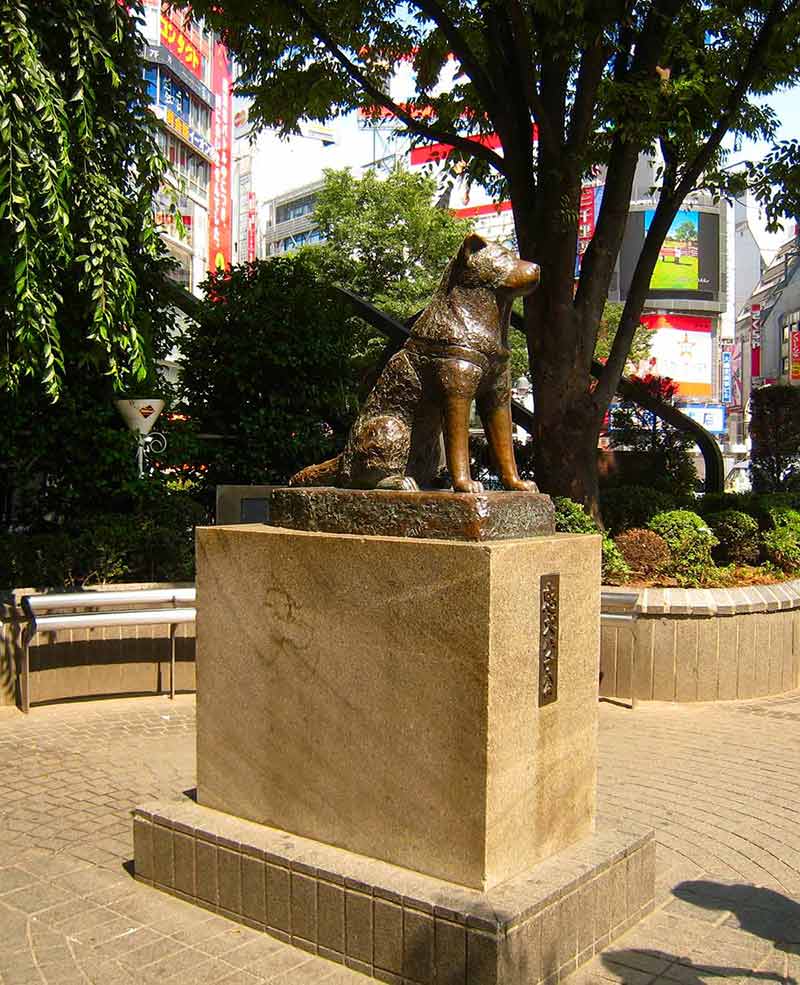
A statue of an Akita dog named Hachiko has stood outside Shibuya station since 1934.
The statue honours a real dog who waited patiently outside the station to meet his owner each night on returning home from work.
After his owner died, Hachiko continued to go to Shibuya station every evening to wait for him.
Hachiko would do this every day for another nine years until he passed away in 1935.
Hachiko’s dedication to his former master earned him national attention and he became a symbol of loyalty and faithfulness even before his death.
Today the statue of Hachiko is a popular meeting place, and in March each year, a ceremony is held to honour the faithful pup.
Hachiko and his owner have since been reunited, buried side by side in Aoyama Cemetery.
The Hachiko Memorial Statue is at 2-1 Dogenzaka, Shibuya City, Tokyo 150-0043.
For more about Japan, read:
- 20 Incredible Landmarks in Japan
- 20 Best Beaches In Japan
- 25 Things To Do In Tokyo At Night
- 25 Landmarks In Tokyo
- A Guide To Winter In Japan
- 50 Things To Do In Japan
- Japan Itinerary (10 days)
- Where To Stay In Tokyo
- Osaka Itinerary
- Nagoya Itinerary
- Where To Stay In Nagoya
- 12 Things To Do in Takayama
- How To Use The Toilets In Japan
- Osaka Itinerary
- 20 Things To Do In Osaka At Night
- Where To Stay In Osaka
- 20 Things To Do In Hiroshima
- Where To Stay In Hiroshima
- 20 Things To Do In Yokohama
- 15 Things Japan Is Famous For
- 20 Things To Do In Kamakura
- 20 Things To Do In Nagano
- 20 Day Trips From Tokyo
- 3 Day Trips From Osaka
- The Most Beautiful Japan Tourist Spots
- Hakuba Hotels
- Hakuba Ski Resort
- Japanese Onsen Tips
- Where To Stay In Kyoto Like A Local
- Arashiyama Monkey Park
- Eating and Drinking Matcha
- Amanemu Review
- 20 Japanese Drinks
- 20 Things To Do In Kyoto At Night
- 20 Japanese Cities
- 20 Things To Do In Fukuoka
- Where To Stay In Fukuoka
- 20 Things To Do In Nara
- 20 Things To Do In Hakone
- 20 Things To Do In Sapporo
- Where To Stay In Sapporo
- 20 Things To Do In Kanazawa
- 20 Things To Do In Okinawa
- 20 Things To Do In Sendai
- 20 Things To Do In Saitama
4- Tokyo Station
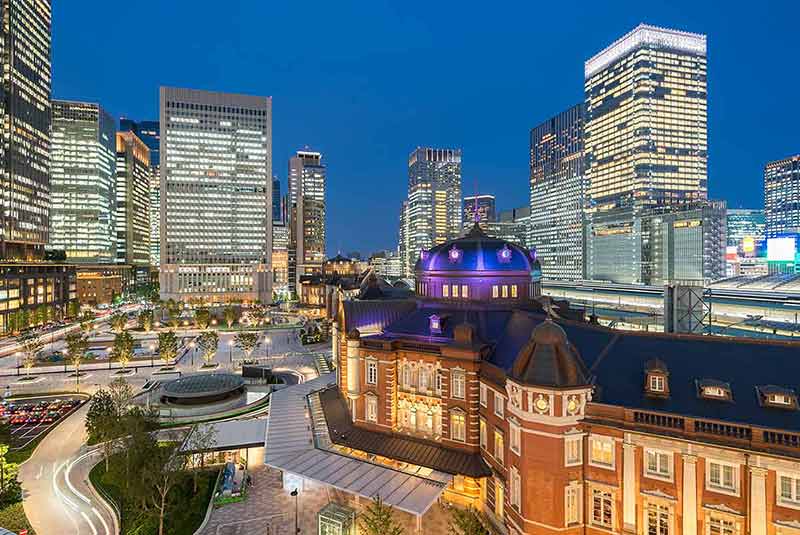
First opened in 1914, Tokyo Station’s striking red brick building is one of the most beautiful buildings in Tokyo.
The station’s design is heavily influenced by grand European-style architecture popular at the time of its design.
Not far from the Imperial Palace, the station has grown rapidly since it first opened.
Originally comprised of just ten platforms, today, nearly half a million people pass through Tokyo Station a day.
Today Tokyo Station houses an excellent art gallery and the Shangri-La hotel, one of the most luxurious hotels in Tokyo.
The station building looks best when lit up at night and is a very popular backdrop for wedding photos with young Japanese couples.
Tokyo Station is at 1 Marunouchi, Chiyoda City, Tokyo 100-0005.
5- Shinjuku Gyoen National Garden

Though Tokyo is famous for its urban sprawl, there are plenty of green spaces throughout the city.
Right in the heart of Shinjuku is one of Tokyo’s most beautiful parks, the 58 ha Shinjuku Gyoen National Garden.
The garden began life as a private residence for a feudal lord in the 18th century before becoming an imperial garden in the late 19th century.
The gardens came under the ownership of the government in 1946 and opened to the public as a national park.
Today the Shinjuku Gyoen National Garden features a diverse range of grounds.
As well as a large traditional Japanese garden, there are also French and English inspired gardens.
The garden is a popular attraction in spring, thanks to its 1,500 cherry blossom trees.
Autumn is also popular when many of the trees turn a vibrant red.
The garden’s traditional Japanese tea house overlooking the Japanese garden is a lovely spot for a cup of green tea.
Shinjuku Gyoen National Garden is at 11 Naitomachi, Shinjuku City, Tokyo 160-0014.
6- Shinjuku’s Godzilla Head
Just a few minutes’ walk away from Shinjuku Gyoen National Garden is a 12 m (39 ft) tall, 80 ton Godzilla head.
Roaring out over the rooftops of Shinjuku, the head of Godzilla appears to burst out from the roof of the Shinjuku Toho Building, a mall containing restaurants and a cinema.
Godzilla’s head has become an unmissable Tokyo landmark at 50 m (164 ft) above ground level.
The fictional monster of Godzilla has plagued the city of Tokyo in dozens of films since its creation in 1954.
Since it first appeared, he has become a cultural icon, and in 2015 he was even named an ambassador for Shinjuku.
For a close-up view of Godzilla, take the elevator up to the café in the lobby of the neighbouring Hotel Gracery on the 8th floor.
From here, you can come face to face to the iconic beast.
The Gracery Hotel also offers several rooms with Godzilla-facing views.
The Godzilla Head is at 1-18-8 Kabukicho, Shinjuku City, Tokyo 160-0021.
7- Gotokuji Temple
Gotokuji Temple is thought to be the origin of mani-neko, the famous waving cat.
According to legend, a stray cat taken in by a monk at the temple gestured towards a samurai lord who had taken shelter beneath a nearby tree during a storm.
Intrigued by the cat, the samurai braved the rain to seek shelter in the temple.
Shortly after, a bolt of lightning hit the tree that the samurai had been sheltering under and the cat was credited with saving the samurai’s life.
Today thousands of cute waving cat statues of all different sizes fill a section of the temple’s grounds.
Commonly known as the cat temple, Gotokuji Temple’s waving cat statues, with their right paw raised, bring good luck.
You can buy a waving cat statue at the temple, with which you can make a wish.
If you place it amongst the temple’s crowd of waving kitties, your wish might just come true.
Gotokuji Temple is at 2-24-7 Gotokuji, Setagaya City, Tokyo 154-0021.
8- Tokyo Skytree
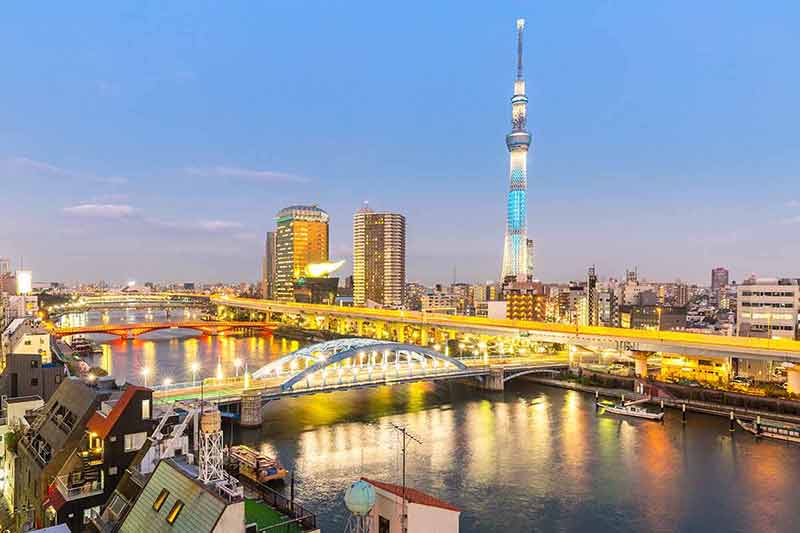
The Tokyo Skytree is the Tokyo Tower’s younger and much taller sibling.
Just like the Tokyo Tower, the Tokyo Skytree is a broadcasting tower with two observation decks.
At 634 m (2080 ft) tall, the Tokyo Skytree is the tallest tower in the world and it dominates the city’s skyline.
The Tokyo Skytree was built to replace the Tokyo Tower as a broadcasting tower.
The Tokyo Tower isn’t tall enough to transmit digital signals, so the Tokyo Skytree was built at almost double the height of the Tokyo Tower.
Located in eastern Tokyo, the views from Tokyo Skytree’s observation decks are arguably the best in the city.
Tokyo Skytree is at 1-1-2 Oshiage, Sumida City, Tokyo 131-0045.
9- The Shibuya Scramble Crossing
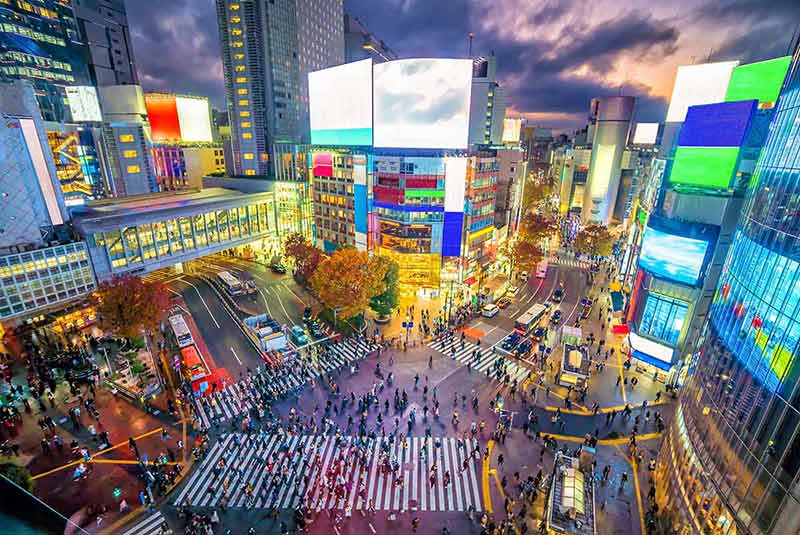
An iconic Tokyo landmark, no visit to the city is complete without seeing the Shibuya scramble crossing.
Situated just next to the statue of Hachiko outside Shibuya Station, the famous Shibuya scramble crossing is one of the world’s busiest pedestrian crossings.
A popular photo spot for tourists, it’s estimated that around 3,000 people use the crossing at a time during the busiest times of the day.
While most visitors queue up to cram into the Starbucks opposite to get a good look at the scramble, the best viewing spot is from the rooftop deck of the Magnet by Shibuya 109 shopping mall.
The Shibuya crossing is at, 1−2−1, Dogenzaka, Shibuya City, Tokyo, 150-0043.
More Landmarks in Asia:
10- Akasaka Palace
Akasaka Palace was built in 1909 to be a home for the Crown Prince but today is used as a state guest house for foreign dignitaries visiting Japan.
Built in a Neo-Baroque style, the palace’s stunning interior features plenty of lavish and opulent touches.
Banquet halls and ballrooms glisten with gold leaf and are decorated with exquisite artworks and crystal chandeliers.
The grand staircase with its plush red carpet has welcomed monarchs and presidents from all over the world.
The palace and the beautifully tended grounds are both open to the public.
Akasaka Palace is at 2-1-1 Motoakasaka, Minato City, Tokyo 107-0051.
11- Ueno Park
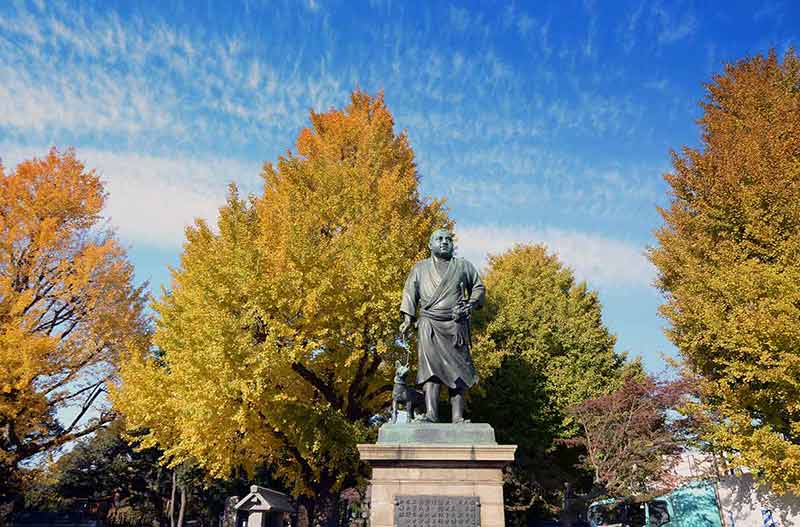
Ueno Park is another of Tokyo’s much loved vast green spaces.
Extremely popular in springtime, thanks to its 800 cherry blossom trees, Ueno Park is much more than just a park.
Within Ueno Park are four world-class museums, the National Museum of Nature and Science, the Metropolitan Art Museum, the National Museum of Western Art and the Tokyo National Museum.
Also in the park is Ueno Zoo, the oldest zoo in Japan, whose star attraction are its two pandas, Lili and Shinshin.
Nearby you can take a paddleboat out onto Shinobazuno Pond.
Among several temples in the park, the most spectacular is the Toshogu Shrine.
Dating from 1627, the shrine is painted in dazzling gold leaf and features numerous intricately carved and brightly painted birds, fish and flowers.
Ueno Park is at 3-chome Ikenohata, Taito-ku, Tokyo, 110-0007.
12- Tokyo Dome
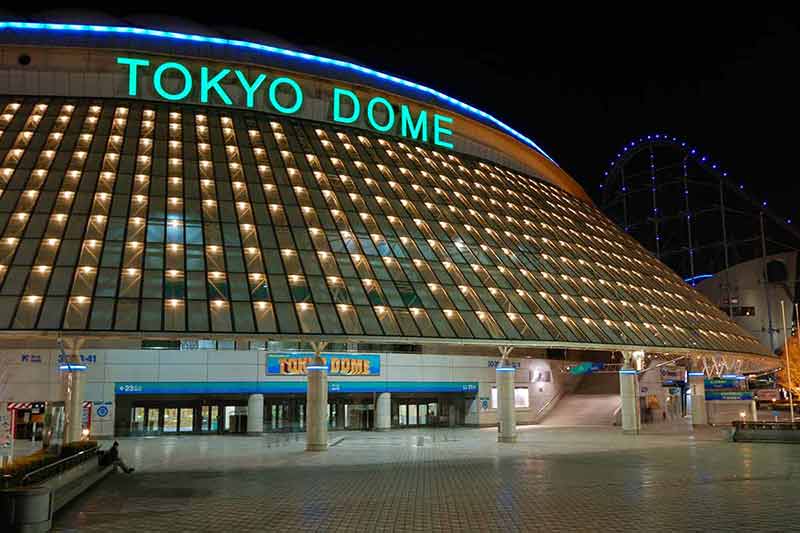
The Tokyo Dome is a multipurpose venue part of the Tokyo Dome City entertainment complex and amusement park.
The Tokyo Dome is predominantly the home of the Yomiuri Giants, the oldest and most successful baseball team in Japan.
The stadium, nicknamed the big egg because of its distinct white roof, doubles up as a 42,000 seat concert venue.
Besides baseball and concerts, the Tokyo Dome has also hosted other international sporting events, including American football games and heavyweight boxing title fights.
Next to the Tokyo Dome is a massive entertainment site dominated by the Thunder Dolphin roller coaster and Big O Ferris wheel.
Tokyo Dome is at 1-3-61 Koraku, Bunkyo City, Tokyo 112-0004.
13- Meiji Jingu Shrine
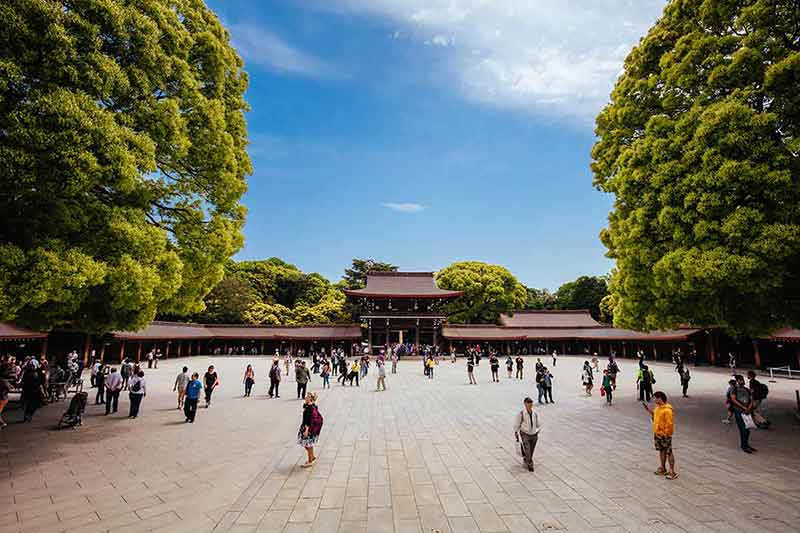
Meiji Jingu is one of the most sacred shrines in Japan and is surrounded by a gorgeous 70 ha (172 acres) forest right in the heart of Tokyo.
Both the forest and the temple were constructed to honour the spirits of the former Emperor Meiji and his wife Empress Shoken.
The shrine complex is reached by passing beneath a series of huge torii gates along a wide path leading to the forest’s centre.
The main shrine building is grand yet relatively austere, reflecting the importance of the spirits enshrined here.
Many ceremonies are held at the shrine throughout the year, the most famous of which is the ring entering ceremony performed by the top-ranking sumo wrestler each January.
The evergreen forest surrounding Meiji Jingu shrine consists of 100,000 trees donated from every prefecture in Japan.
Meiji Jingu Shrine is at 1-1 Yoyogikamizonocho, Shibuya City, Tokyo 151-8557.
14- Takeshita Dori
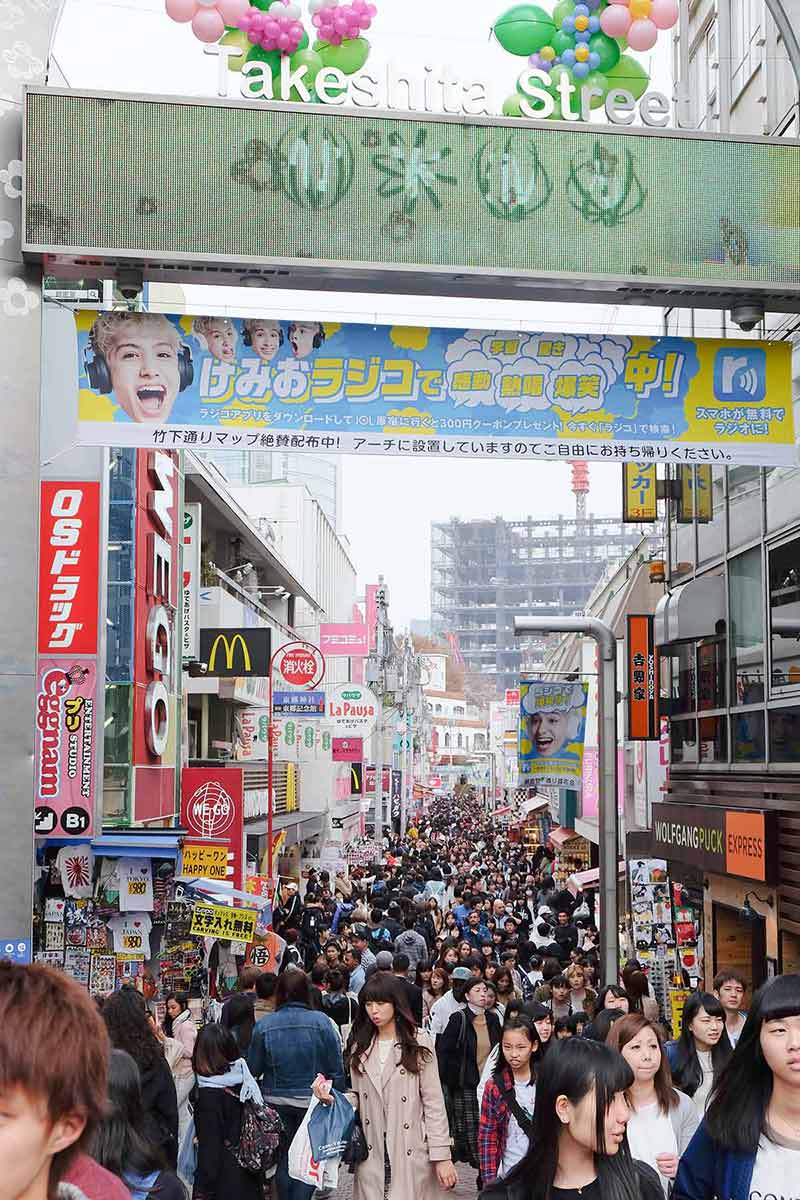
A short distance from the entrance to Meiji Jingu forest is Takeshita dori.
Right at the heart of Harajuku, Tokyo’s youth culture capital, Takeshita dori is home to all things cute and kawaii.
At only 400 m long, Takeshita dori is a multi-coloured riot of youth fashion stores, vintage clothes shops and cartoon-themed cafés.
The entrance to Takeshita dori is directly opposite Harajuku Station, marked by a typically colourful archway that is usually adorned with a bold display of balloons shaped like flowers.
Hugely popular with Tokyo’s teens, especially on weekends, Takeshita dori is an eye-opening and often bewildering glimpse into Japanese pop culture.
Takeshita dori is at 1-6 Jingūmae, Shibuya City, Tokyo 150-0001.
Discover more Famous World Landmarks:
- 25 Australian Landmarks
- 20 New Zealand Landmarks
- 20 African Landmarks
- 21 Egyptian Landmarks
- 20 Jordan Landmarks
- 10 Tasmanian Landmarks
- 20 Antarctica Landmarks
15- Fuji TV Network Headquarters Building
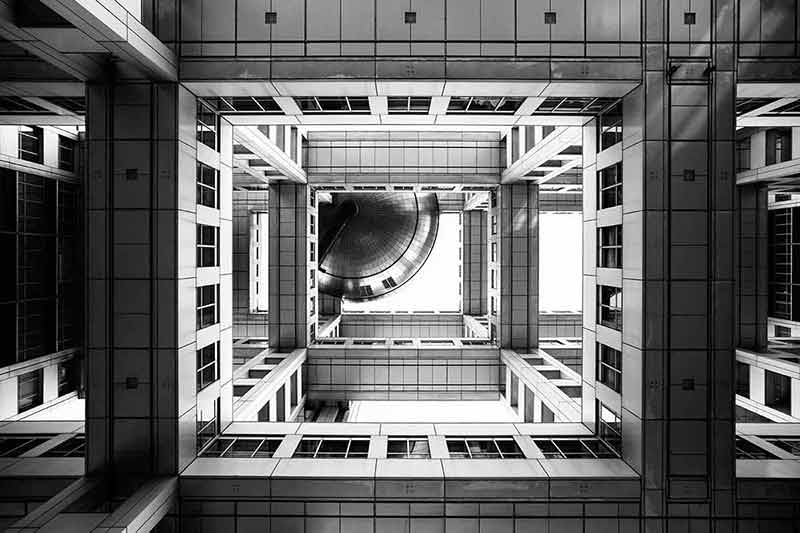
The headquarters of Japanese television company Fuji TV is one of the most instantly recognisable buildings in Odaiba.
Featuring a mechanical and futuristic design, the spherical dome sits towards the top of the building that makes the Fuji TV Headquarters such a famous Tokyo landmark.
As well as being an architectural icon, the spherical dome at the top of the Fuji TV Headquarters building is also home to an observation deck called Hachitama.
The deck has some of the best views of Odaiba, the Rainbow Bridge and central Tokyo.
For the best views, be sure to arrive in the late afternoon to see a beautiful sunset and incredible views of Tokyo at night.
The Fuji TV Network Headquarters is at 2-4-8 Daiba, Minato City, Tokyo 137-8088.
16- Unicorn Gundam Statue
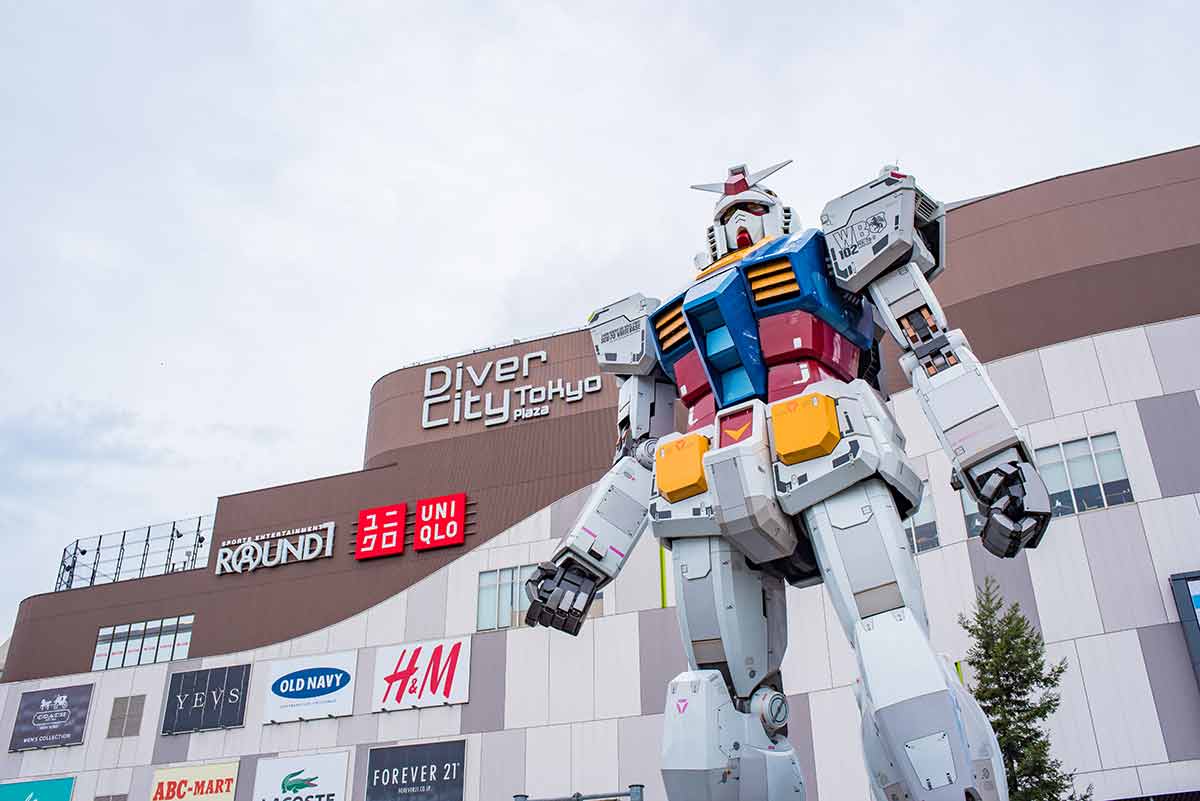
Japan loves to honour its anime and manga heroes with a statue, and Gundam is probably the most famous of them all.
Standing outside the Divercity Tokyo Plaza Mall in Odaiba is Gundam’s 20 m (67 ft) tall statue, a fictional robot and star of the long-running Japanese manga and anime series Mobile Suit Gundam.
As Odaiba hosts many anime and manga events throughout the year, the Unicorn Gundam Statue has become an iconic and much-loved Tokyo landmark.
The current statue of Gundam is the second to have been displayed here.
The current RX-0 Unicorn statue replaced the RX-78-2 Gundam statue in 2017.
The Unicorn Gundam Statue is at 1−1−10, Aomi, Koto City, Tokyo, 135-0064.
17- Tokyo Metropolitan Government Building
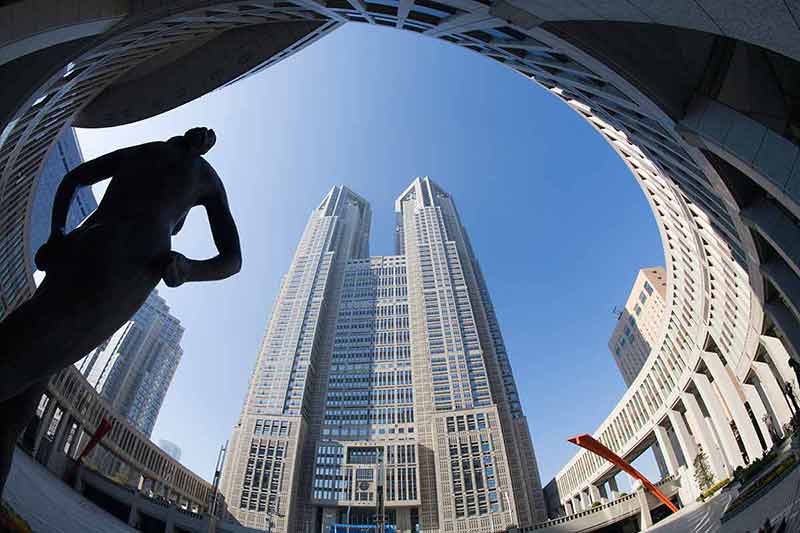
Though there are more famous observation towers in the city, the Tokyo Metropolitan Government Building is easily one of the most popular.
Located just to the west of Shinjuku Station, the Tokyo Metropolitan Government Building is actually made up of two identical buildings with an observation deck on the 45th floor.
Besides the stunning 360 degree views of Tokyo, the main appeal of the Tokyo Metropolitan Government Building’s observation decks is that they are free to visit.
The two observation decks offer a very similar view, so you’d only need to visit one. Both also have souvenir shops and a café.
At just over 200 metres above ground level, the views across the city and way beyond are spectacular on a clear day.
The Tokyo Metropolitan Government Building is at 2-8-1 Nishishinjuku, Shinjuku City, Tokyo 163-8001.
18- Roppongi Hills
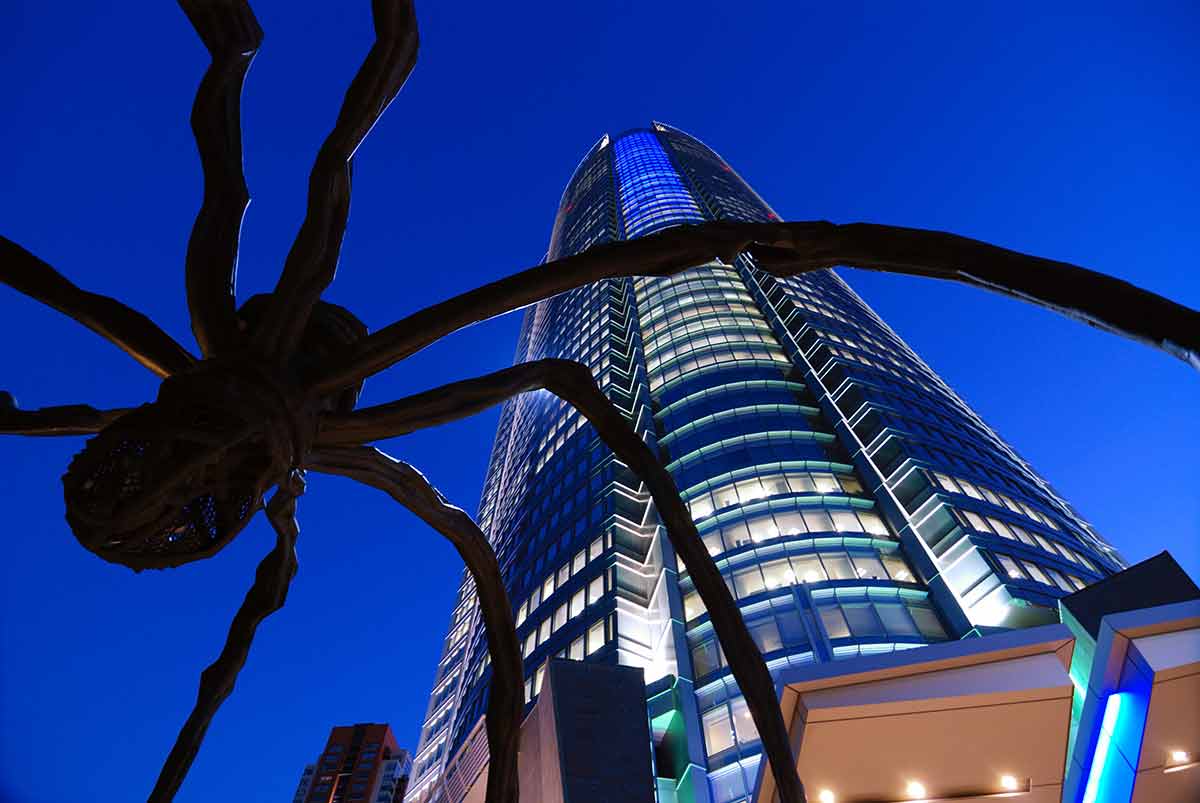
Roppongi Hills is a massive development of art galleries, shops, restaurants and an observation deck in central Tokyo.
At the centre of Roppongi Hills is the Mori Tower, a 54-storey skyscraper that has become a modern Tokyo landmark.
Although it’s mostly used for commercial office space, the Mori Tower is also home to two of Tokyo’s best art galleries, the Mori Arts Center and the Mori Arts Museum, located across the tower’s 49th to 54th floors.
The Mori Tower is also the location of another of Tokyo’s many observation decks.
Spread across two levels, the indoor Tokyo City View on the 52nd floor offers mesmerising city views.
Meanwhile, the tower’s Sky Deck observatory one floor up offers incredible unblocked open-air views of Tokyo’s entire skyline.
Roppongi Hills is at 6-10-1 Roppongi, Minato City, Tokyo 106-6108.
20- Mount Fuji
Though located about 60 miles (96 km) from Tokyo, Japan’s most famous landmark is visible from the city on clear days.
An iconic symbol of Japan, Mount Fuji is much more than just a mountain. Depicted in numerous major artworks, Japan’s tallest mountain is considered a sacred site and has been a place of pilgrimage for many centuries.
In 2013 Mount Fuji was declared a UNESCO World Heritage Site.
The clearest views of Mount Fuji from Tokyo can be seen during the autumn and winter months.
From November to February, Tokyo’s skies are usually clear of fog, cloud and haze and on sunny days, you can easily spot Mount Fuji from higher vantage points.
Any of Tokyo’s observation decks will offer exceptional views of Mount Fuji, which is usually most visible in the early morning and the late afternoon just before sunset.
Mount Fuji is at Kitayama, Fujinomiya, Shizuoka 418-0112.
For more amazing European Landmarks, read:
- 30 Spain Landmarks
- 20 Switzerland Landmarks
- 22 Germany Landmarks
- 35 London Landmarks
- 30 France Landmarks
- 20 Italy Landmarks
- 20 Greece Landmarks
- 20 Russia Landmarks
- 20 Scotland Landmarks
- 20 Ireland Landmarks
- 21 Wales Landmarks
- 20 Turkey Landmarks
- 20 England Landmarks
- 20 Hungary Landmarks
- 21 Romania Landmarks
- 20 Ukraine Landmarks
- 20 Athens Landmarks
- 20 Rome Landmarks
- 20 England Landmarks
- 20 Portugal Landmarks
- 20 Poland Landmarks
- 20 Iceland Landmarks
- 20 Bulgaria Landmarks
- 21 Croatia Landmarks
- 20 Bulgaria Landmarks
- 20 Austria Landmarks
- 21 Finland Landmarks
- 20 Sweden Landmarks
- 20 Denmark Landmarks
- 20 Belgium Landmarks
- 20 Netherlands Landmarks
- 20 Barcelona Landmarks
- 21 Czech Republic Landmarks
- 20 Landmarks in Paris
- 20 Landmarks in Liverpool
- 10 Istanbul Landmarks
Plan Your Trip

Rent A Car – Find the best car rental rates at Discover Cars. They compare car hire companies to provide you with the best deal right now.

Find A Hotel – If you’re curious about this article and are looking for somewhere to stay, take a look at these amazing hotels.

